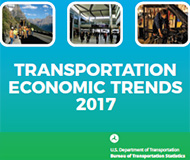1/18/2018
Cost Of Driving Down, Except Tolls And InsuranceSharp rise in government-imposed costs not enough to offset larger reductions in the cost of owning an automobile.

In recent years, automobile ownership has become more affordable, apart from a surge in the cost of toll roads, insurance and government fees. The US Department of Transportation's Bureau of Transportation Statistics ran the numbers in a report released last week covering economic data related to the industry between 2015 and 2016.
The numbers show the overall cost of private transportation dipped 2.2 percent, with government and the insurance industry imposing costs that threaten to reverse that positive trend. The cost of parking fees and tolls rose 2.8 percent, taxes on automobiles went up 2.1 percent and auto insurance premiums spiked 6.2 percent.
State and local governments often turn to the motorist to fill budgetary holes or to find ways of boosting revenue without directly voting to increase income or property taxes. The Virginia Department of Transportation (VDOT), for example, came under criticism last month for charging $44 tolls for motorists to drive ten miles. There was no vote of elected lawmakers approving that state-run tolling project. On the rest of its major highways, VDOT has begun outsourcing toll collection to foreign companies. In other states like California, lawmakers did vote for a massive increase in the gasoline tax and vehicle registration fees.
Automobile insurance is run by private companies, but government helps determine how much motorists pay. Aside from imposing regulatory costs, every time a police officer writes a traffic ticket, an insurance company can raise rates on the recipient. One peer reviewed study drew links between the industry's increased profits and the reduction in payouts on accident claims to suggest the premium increases are not actually related to the number of accidents.
As those costs soared, the prices of new and used cars dropped half a percent, and the amount of cash needed to fill the tank dropped 11.5 percent. Spare parts and tires likewise became slightly less expensive. Motorists took advantage of the relief by racking up 7.9 percent more miles traveled over the past three years.
Motorists continue to play a major role in the national economy, with consumer spending on automobiles hitting $1 trillion. One third of the amount went to the purchase of new and used vehicles, and one-fifth was spent on gasoline. By comparison, consumers spent just $21 billion on transit, in addition to $6 billion on intercity bus, train and ship fares. Taxi fares accounted for another $6 billion.
A copy of the report is available in a 5mb PDF file at the source link below.


